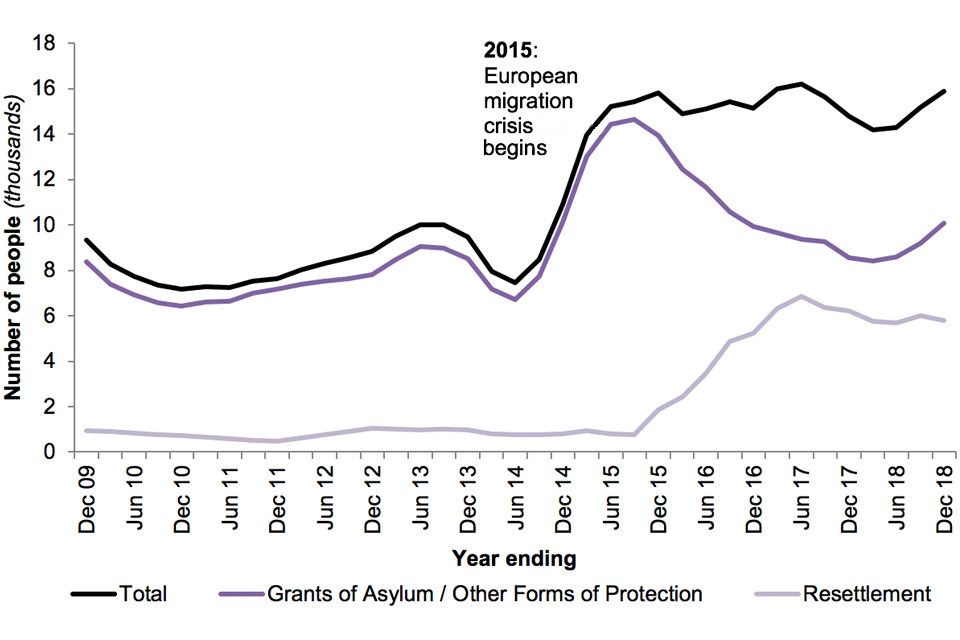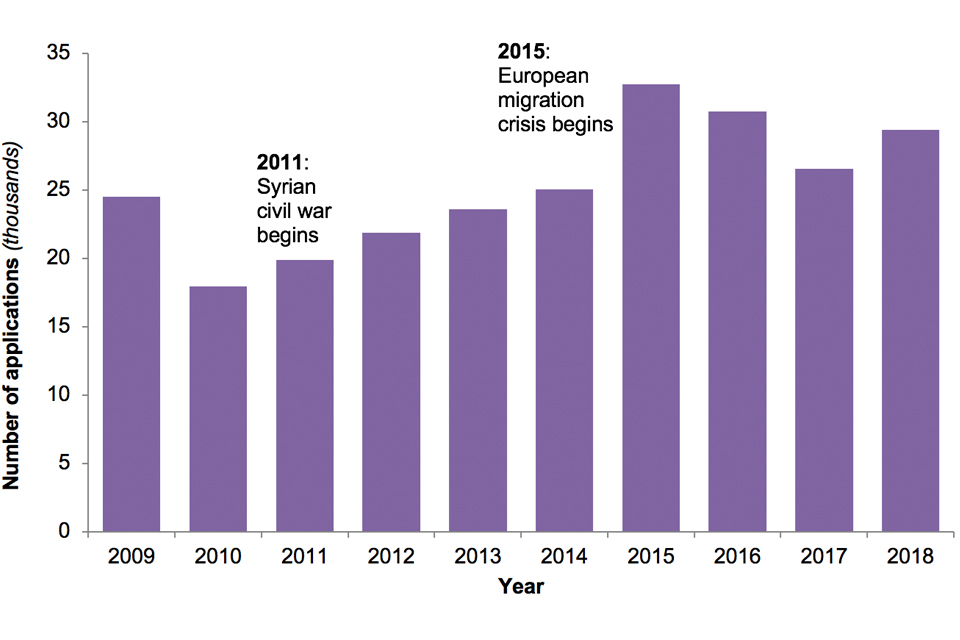How many people do we grant asylum or protection to?
Published 28 February 2019
Back to ‘Immigration Statistics, year ending December 2018’ content page.
This is not the latest release. View latest release.
Data relate to the year ending December 2018 and all comparisons are with the year ending December 2017, unless indicated otherwise.
This section contains data on:
- asylum applications and initial decisions, including unaccompanied asylum-seeking children (UASC)
- resettlement
- Family reunion visas granted
- asylum support
- Dublin Regulation
The Home Office provides a more detailed commentary on an annual basis. The latest detailed annual commentary is included in ‘Immigration statistics, year ending June 2018’.
1. Asylum, resettlement and protection
The UK offered protection – in the form of grants of asylum, alternative forms of protection and resettlement – to 15,891 people in 2018 (up 8% compared with the previous year). Of these, 42% (or 6,628) were children.
The total number of people offered protection each year has been around this level since early 2015, and in 2018 comprised:
- 7,636 grants of asylum (up 2%). There were notable changes in grants to Turkish (up 332), Iranian (down 381), Eritrean (down 358) and Sudanese (down 315) nationals
- 2,449 grants of an alternative form of protection (more than doubled), driven predominantly by an increase of 1,042 grants of humanitarian protection, particularly to Libyan nationals (up 907)
- 5,806 people provided protection under resettlement schemes (7% fewer than the previous year)
Figure 7: Grants of asylum, resettlement1 and other forms of protection, 2009 to 20182

Sources:
Asylum table as 02 q (volume 2) and Asylum table as 19 q (volume 4)
Chart notes:
- Resettlement data prior to 2013 are only available annually. Data for individual quarters in this period have been estimated by taking 25% of the annual total.
- Includes main applicants and dependants.
The Vulnerable Person Resettlement Scheme (VPRS) accounted for three-quarters (4,407) of those resettled in the UK in 2018. Since it began in 2014, 14,945 people have now been resettled under the scheme. A further 688 were resettled under the Vulnerable Children Resettlement Scheme (VCRS) over the last year.
Of those resettled under the VPRS and VCRS in 2018, 130 refugees were resettled in the UK through the Community Sponsorship scheme. Since the scheme began in July 2016, 219 refugees have been resettled by community sponsor groups. Details of the scheme can be found in the ‘About the statistics’ section.
Additionally, 5,900 Family reunion visas were issued to partners and children of those granted asylum or humanitarian protection in the UK (up 13%).
There were 29,380 asylum applications in the UK from main applicants in 2018, 11% more than the previous year. Although this remains below levels seen in 2015 and 2016 during the European migration crisis, the number of applications in the latest quarter was the highest level since 2015 quarter 4, with notable increases in applications from Iranians, Iraqis and Albanians.
The total number of asylum applications to the EU in 2018 was an estimated 612,600, down 11% from the previous year, following the 45% fall in 2017. In the latest statistics, the UK received the 6th highest number of applications of all the EU member states.
There were particularly notable increases in asylum applications to the UK from:
- Eritrean nationals, up 1,073 (nearly doubled) to 2,158
- Iranian nationals, up 757 (29%) to 3,327
- Albanian nationals, up 571 (40%) to 2,001
On 8 January 2019, the Home Office published a fact sheet on the number of people attempting to cross the channel on small boats. This showed that 543 people attempted to cross to the UK from France in this way in 2018, with 80% (438) attempting to cross between October and December. This number is less than 2% of the number of asylum applications received over the same period.
There were 2,872 applications from UASC, 20% more than the previous year. UASC accounted for 10% of total asylum applications.
Figure 8: Asylum applications in the UK, 2009 to 20181

Source:
Asylum table as 01 q (volume 1)
Chart note:
- Includes main applicants only.
In 2018, 33% of initial decisions on asylum applications were grants of asylum or alternative forms of protection (such as humanitarian protection or discretionary leave), similar to the previous year. Data from the Home Office ‘cohort’ analysis, published annually in Asylum table as_06, show that the final grant rate increases to around 50% following appeal.
Grant rates vary by nationality. There were some notable changes in grant rates at initial decision in 2018 for nationals of:
- Libya (96%, compared with 50% in the previous year)
- Turkey (38%, compared with 16% in the previous year)
- Sudan (44%, compared with 62% in the previous year)
2. Support provided to asylum seekers
At the end of December 2018, 44,258 asylum seekers in the UK were in receipt of support under Section 95 of the Immigration and Asylum Act 1999, up 9% from the previous year.
Of these, 41,309 (93%) were in receipt of both accommodation and subsistence, and 2,949 (7%) in receipt of subsistence only. The majority (82%) were located in England, with smaller supported populations in Scotland (9%), Wales (6%) and Northern Ireland (2%).
In 2018, there were 17,518 applications for Section 95 support, an increase of 11% compared to the previous year.
An additional 4,016 individuals were in receipt of support under Section 4 of the Immigration and Asylum Act 1999, down 2% from the previous year. A further 2,129 individuals were in receipt of support under Section 98 of the Act, 18% more than the year before.
3. Dublin Regulation
In 2018, there were 1,940 requests from other member states to transfer individuals into the UK under the Dublin Regulation, and 5,510 requests from the UK to transfer individuals out of the UK to other member states.
Over the same period, there were 1,215 transfers into the UK under the Dublin Regulation. The majority (946) of these transfers came from Greece.
There were 209 transfers out of the UK under the Dublin Regulation. A quarter of these (51) were transfers to France.
4. About the statistics
This section provides information on those applying for and granted protection in the UK through both asylum and resettlement routes, as well as information on the numbers in receipt of asylum support.
The data are used to assess the trends in numbers of people seeking and being granted protection, the impact of policy changes, and to understand the demographics of those coming to the UK to claim protection. Data on resettlement and support, broken down by local authority, can help local authorities understand the demands on their services and resources to aid with planning.
Asylum, resettlement and protection
The total number of individuals granted protection includes grants related to an asylum application (grants of asylum or alternative protection) and resettlement. Alternative forms of protection include humanitarian protection, discretionary leave, UASC leave, leave outside the rules, and grants under family and private life rules. Further details can be found in the user guide.
Data on asylum applications relate to the period in which the application was lodged, and initial decisions relate to the period in which the decision was made. Initial decisions may, therefore, relate to an application made in an earlier period, and thus the two are not directly comparable.
Data on initial decisions will not reflect the total number of people granted protection through asylum routes as some initial decisions may be overturned following appeal. Data on the number of appeals lodged, and their outcomes, are published in Asylum tables, volume 4.
UASC data includes those treated as an unaccompanied minor for at least one day between the date of application and the date of initial decision. Some UASC applicants may subsequently be found to be an adult following clarification of an age dispute. Data on age disputes are published in Asylum tables, volume 3.
Figures on international asylum applications are based on data supplied by the individual countries to the Intergovernmental Consultations on Migration, Asylum and Refugees (IGC), United Nations High Commissioner for Refugees (UNHCR) and Eurostat. These may include some estimated figures. Eurostat also publishes a range of asylum statistics which can be used for comparisons across the EU. The methodology used to compile Eurostat data differs from that used in this release. Further details can be found in the user guide.
The UK Community Sponsorship scheme was launched on 19 July 2016. The scheme allows community groups to support refugee families directly and aims to help them become self-sufficient and integrated members of the community. These figures are a subset of those published under the VPRS and VCRS and are not in addition to those resettled under these schemes. Further details can be found on the Community sponsorship scheme launched for refugees in the UK, GOV.UK page.
Family reunion visas are a subset of the ‘Family: other’ visa category, published in the visa tables, of which around 99% relate to Family reunion visas. Data on Family reunion visas come from a different administrative system to other visa data so are not directly comparable. Further details can be found in the user guide.
Support provided to asylum seekers
Section 95 support is provided to destitute asylum seekers until their claim is finally determined, which may encompass either accommodation or subsistence, or both. ‘Invalid applications for support and support type not yet known’ are cases that have been deemed invalid or which have not yet been assessed.
Section 4 provides support for individuals whose claim has been refused and who have exhausted their appeal rights, but who are destitute and are temporarily unable to leave the UK.
Section 98 support provides accommodation for asylum seekers who would otherwise be destitute and who are either awaiting a decision on an application for Section 95 support or are supported under Section 95 and are awaiting transfer to their accommodation.
The data show the number of people in receipt of support on a given day, but do not show the length of time for which someone receives support or the amount of support they receive.
Dublin
Dublin data are published on an annual basis in February.
The Dublin Regulation is EU legislation that establishes the criteria and mechanisms for determining which single state is responsible for examining an application for international protection. The criteria for determining the Dublin state responsible for examining the asylum claim, along with further details on the Dublin Regulation, are set out in the user guide.
The data show the number of requests from other member states to transfer an individual into the UK, and the number of individuals transferred into the UK under the Dublin Regulation. They also show the number of requests from the UK to other member states to transfer an individual out of the UK, and the number of individuals transferred out of the UK.
Data on arrivals relate to the period in which the individual arrived in the UK, removals relate to the period in which the individual was removed from the UK, and requests for transfer in/out relate to the period in which the request was made.
Data on transfers out of the UK under the Dublin Regulation are a subset of the published returns data found in ‘How many people are detained or returned?’.
5. Data tables
Data referred to here can be found in the following tables:
- Asylum tables volume 1
- Asylum tables volume 2
- Asylum tables volume 3
- Asylum tables volume 4
- Asylum tables volume 5
We welcome your feedback
If you have any comments, or suggestions for the development of this report, please provide feedback by emailing MigrationStatsEnquiries@homeoffice.gov.uk. Please include the words ‘PUBLICATION FEEDBACK’ in the subject of your email.
See section 7 of the ‘About this release’ section for more details.
